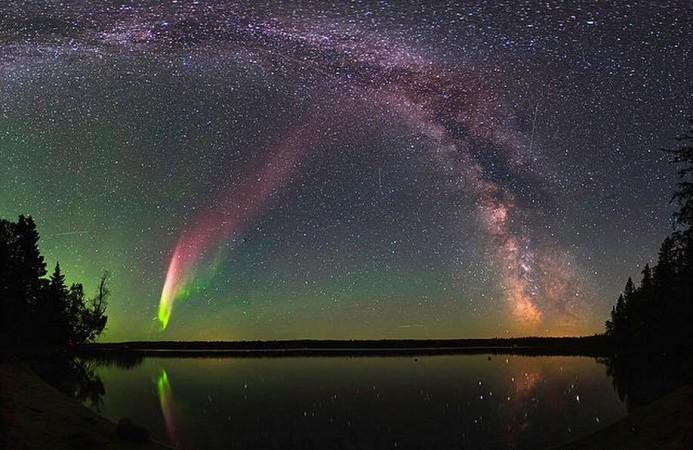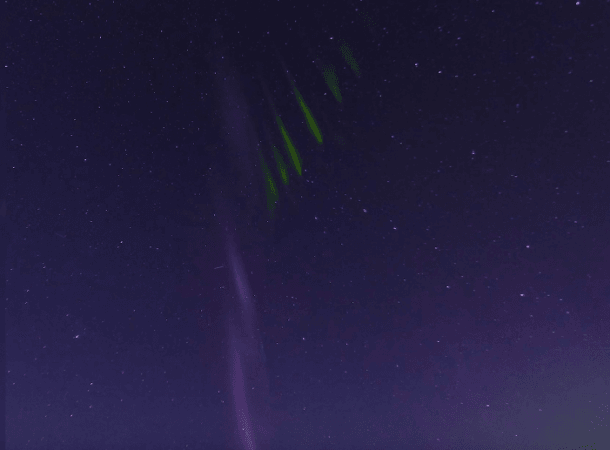
- Aurora Steve was first observed by multiple citizen scientists.
- The purple streak with green accents is seen at lower latitudes than usual auroras.
- Steve is caused by certain "subauroral ion drift" (SAID) particles.
- SAIDs travel along Earth's maginetic fields closer to the equator.
Citizen scientists — people who are excited about a particular field of science but don't have the educational background for it — recently observed a mysterious purple ribbon of light that streaked across the sky in western Canada.
Reports of the sighting were shared with Aurorasaurus, a citizen-science project funded by NASA and the U.S. National Science Foundation, and researchers identified that this ribbon – previously known as a "proton arc" – is actually a feature caused by the sun's radiation traveling along different magnetic field lines than usual auroras.
In a new paper pubslihed in Science Advances, this phenomenon – or unique streak of purple – has been dubbed as Steve. The name is an acronym for "Strong Thermal Emission Velocity Enhancement."
The paper states that this string of purple with green accents, which usually occurs at lower altitudes that normal auroras do, is able to give scientists new insights about the interactions of Earth's magnetic field and the upper atmosphere.
Elizabeth MacDonald, the study's lead author from the NASA Goddard Space Flight Center, credited citizen scientists for the remarkable discovery. "It's gratifying to show what citizen science can do," she said. "Some people think it's just education and outreach, but it's actually real science, and people working together in ways that we never anticipated."
Scientists' understanding of Steve changed the night when Notanee Bourassa, a Canadian citizen scientist, had snapped photos of the streak for the first time. However, Bourassa wasn't the only one doing that.
Ground-based cameras run by the University of Calgary, Canada, and University of California, Berkeley, also happened to take photos of large areas of the sky where Steve was on display. Coincidentally enough, the European Space Agency's Swarm satellite was passing over the exact area at the same time and was able to capture the phenomenon from above as well.
The first satellite documentation of Steve thus provided experts with a better picture about the Earth's magnetic field interacting with particles in space. "This is a light display that we can observe over thousands of kilometers from the ground," said MacDonald, explaining it further.
"It corresponds to something happening way out in space. Gathering more data points on STEVE will help us understand more about its behavior and its influence on space weather," she added.
But what exactly is Steve?
The study highlights the fact that Steve is not a normal aurora. While both types of auroras are created in the same way, the key difference between them lies in the details of appearance.

Normal auroras occur in an oval shape and are observed near the polar regions of Earth. They last for hours and are seen in shades of greens, blues and reds. But Steve was a purple dancing streak with a green fence, observed for about 20 minutes to an hour, at most.
Also, Steve was observed to flash at much lower latitudes – meaning it was a result of charged particles interacting with magnetic field closer to the equator.
Combining all of the data collected by citizen scientists and space agencies led to the hypothesis that a feature called "subauroral ion drift" (SAID) is what causes Steve.

SAIDs are westward flowing particles, moving faster than the speed of sound. They flow in thin jets closer to the equator than other light-causing particles. They usually don't come with lights, and the ones that do aren't explained by the paper. However, it is noteworthy that certain emissions tied to SAIDs are red, but Steve's are green – leaving more room for further science.
But as of yet, thanks to citizen scientists, there's definitely some light shed on the phenomenon.
"Steve can help us understand how the chemical and physical processes in Earth's upper atmosphere can sometimes have local noticeable effects in lower parts of Earth's atmosphere," said MacDonald. "This provides good insight on how Earth's system works as a whole."

















